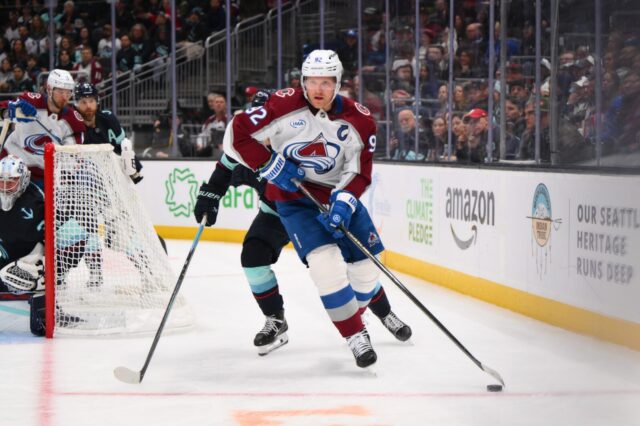The Avalanche have been locked out of NHL success for years, but for the first time in a while it appears they may have found the keys.
It’s not yet polished. Even with a young team and exciting prospects, there are moments of panic on the ice for the Avalanche. For example, a smooth pass sails out of the zone and there’s a scramble for the team to regain composure. It’s not the lack of talent that keeps fans on edge now — it’s a lack of experience.
While it seems counterintuitive, this problem is incredibly refreshing. Almost everything about the way the Avalanche are now running this team is refreshing.
You see, the Avalanche fell into a trap. This trap was not the defensive scheme that bores hockey fans to death. It was a calculated assault on their way of doing business in which the whole league conspired against them.
The NHL’s lockout in 2004-05 punished the Colorado Avalanche more than any other team in the league. It was meant to punish them.
The Avalanche, with their two Stanley Cups and six Western Conference Finals appearances from 1996-2002, was the envy of the NHL. Relocated from Quebec, they were built for an era where money talked. And the Avalanche made their money sing — pulling off trades and free-agent signings to make a good team into a great one. Those teams featured at least five Hall of Famers. They also continued to draft well and develop players like Milan Hejduk, Alex Tanguay and Chris Drury.
NHL owners had to be put off that the Avalanche had so much, while bad management hurt most other teams in the league.
The league claimed to bleed money, which was coupled with the poor management of most teams. They were — somehow — not able to compete with a mid-market team from a Cowtown in the Rocky Mountains, so they set out to annihilate the Avalanche. Not only did they change the way the NHL does business with a salary cap, they withheld information on contract details to Joe Sakic and Rob Blake so that the financial strain was even worse.
How did the Avalanche respond?
They didn’t, really. They continued to stock the roster with veterans and “old school” NHL guys. They faltered in the draft and traded away assets. While the rest of the NHL was learning how to budget, the Avalanche were cashing in each cap dollar as a payday loan –the pain always pushed into the not too distant future. The work never got them out of the second round of the playoffs. The roster debt further sunk the team. They hit rock bottom in 2009, ’11 and ’13. Last year they were the worst NHL team to take the ice in the shootout era.
After each fall it seemed they’d surely learn their lesson. They would start recommitting to prospects and move away from old NHL players. They would going to get fast and build talent within the organization.
They actually looked poised to do this twice in the last decade. Unfortunately, they made the playoffs both times (2010 and ’14) and suddenly cashed in for a chance at a Stanley Cup, destroying the young culture. It took last year to really hit rock bottom and force Sakic, the club’s Vice President and General Manager, to find a new way or lose his job.
The moves of the last eight months speak to this new strategy. Sakic kept a coach, Jared Bednar, known for developing young talent in the AHL. He chose to fill the roster with young guys so that they could gain experience instead of signing declining veterans. He pulled off a trade of Matt Duchene for six prospects and a goalie.
This is a new Avalanche strategy. It’s not about sacrificing the future for the present. This strategy isn’t the aptitude over attitude problem some organizations fall into at times when they only focus on advanced stats. It’s not even an old-school guy wanting to reclaim his glory days. It’s how you build a team in the salary cap era.
It also is infecting other parts of the organization.
They’re utilizing the investment in the entertainment department. We’re talking Jumbotrons, on-ice projections, high-quality speakers and lights. They’ve enabled their talent on TV, in media relations and in the arena. The one remaining entertainment step would be to try to match the excellent quality of the Colorado Rockies’ Twitter account.
Additionally, the marketing department is more flexible than it’s ever been. They never cultivated a great strategy after the glory days. At times, they seemed to want to make the ticket buying process harder, rather than easier. Now they’re offering a host of promotions and deals to get people into the arena. Investment in new fans now will bring home real dollars when they have playoff success.
This Avalanche renaissance only pays off if the talent develops and the wins follow. They have to stay this course and not leap out for a short-term trade. They have to continue to invest in new fans and broaden their reach in Denver and across the entire Front Range.
Of all of the recent rebuilds, I like this foundation the best. They’re winning home games. On top of Gabriel Landeskog and Nathan MacKinnon, they have forwards like Mikko Rantanen, Tyson Jost and Alexander Kerfoot. Plus, 19-year-old Sam Girard, acquired in the Duchene trade, an exciting young defenseman.
The key to success in the NHL now is patience. For a game that’s fast, the Avalanche finally seem ready to take the scenic view.



